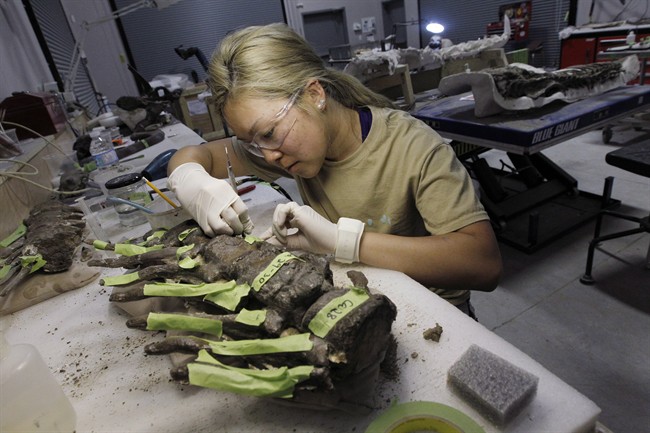TORONTO – Peter May never dreamed that answering a newspaper ad in 1977 would eventually fill the world’s museums with hundreds of dinosaur skeletons.

The call for a paleontology technician at the Royal Ontario Museum didn’t initially seem like a fit for a steel company employee who hadn’t shown the slightest interest in raptors as a child.
But the job secured through that ad ultimately led May to launch Research Casting Inc., a company that’s been placing fossil replicas in museums from Argentina to Japan for the past 28 years.
READ MORE: New feathered dinosaur fossil unearthed in China
The past and present collide in Research Casting’s Trenton, Ont., factory, where 25 workers use modern materials and technology to recreate the remains of creatures that haven’t walked the Earth for millions of years.
It’s a surprising career path for May, who answered the ROM’s ad on a whim and fell asleep from boredom while researching paleontology in preparation for the interview.
Once he saw people in action duplicating pieces of history, however, he was instantly hooked.
“I got all excited about the mould-making and how they were doing it,” May said in a telephone interview. “I was dressed as best I could – good pants and a sweater. I came out filthy. I probably would have volunteered.”
May, who landed the ROM job on the spot, spent five years there before moving to Alberta to help set up the country’s best-known dinosaur museum. His years at the Royal Tyrrell Museum in Drumheller, Alta., got him familiar with the intricacies of both preserving original dinosaur bones and creating realistic replicas out of materials like fibreglass or bronze.
READ MORE: New horned dinosaur discovered in Alberta
When May returned to Ontario, he brought his newfound love of dinosaur casting with him and began producing models in his spare time.
When the number of orders piled up to total $1.2 million, May took his enterprise full time and has been stocking the world’s museums ever since.
May said Research Casting’s output largely helps take paleontology exhibits to the next level by producing models fit for public exposure.
While the company is often hired to help preserve original bones, the unique specimens are too rare and fragile to be part of most regular museum displays.
The moulds and casts produced on the factory floor allow the museums to get more creative in the way they stage their exhibits, he said.
Peter Root, director of facilities operations at Amhurst College in Massachusetts, said preservation techniques allowed the school’s Museum of Natural History to completely reconfigure its one-of-a-kind collection of fossilized dinosaur footprints.
WATCH: Researcher snaps piece off 375 million-year-old fossil
The originals, known as trackways, used to be awkwardly displayed on a wall before Research Casting produced replicas that allowed for a much more interactive exhibit.
“One was a fairly large one (trackway) that we imbedded in the floor of the museum as part of the display,” he said. “People could actually walk on it, touch it, kids could put their feet in the tracks themselves.”
These days May said his staff is providing interactive material through a whole new channel.
Traditional techniques are giving way to digital scans, and May said the data that forms the basis of modern replicas can also be used as part of a museum’s exhibit.
These days may only spends about 10 per cent of his time making reproductions, adding he relishes the rare opportunities to both revisit his old craft and learn about the more high-tech methods.
He said the fact that he’s passed the torch to a new generation, however, is good news for both his clients and the historical record.
“My crew here does a much better job than I ever did,” he said. “They’re light years ahead of what we used to do in the late 80s and early 90s.”



Comments